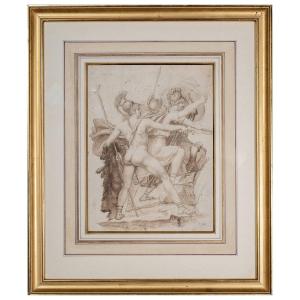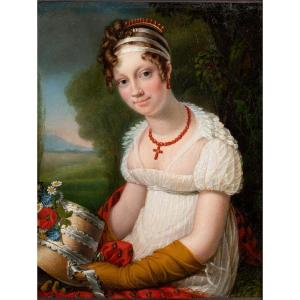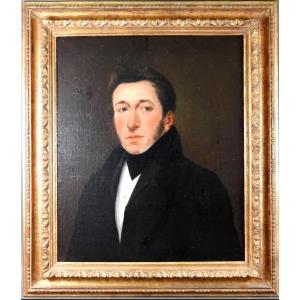Portrait of the Countess de Ségur
Circa 1833-1834.
Oil on canvas.
H: 64.5 ; W: 54 cm.
Exhibition: Salon des Artistes Vivants, Paris, 1834, no. 958: “Portrait de Mme de S***”.
This portrait depicts a woman dressed in black, a translucent veil delicately draped over her head and shoulders. The lace, created by the thicker paint on the canvas, frames the model's serene face, which evokes a slight smile. The softness of the latter's features is rendered by subtle fading of the skin tones and the sober background of the work.
Hortense Haudebourt-Lescot is a French painter renowned for her genre scenes and portraits. Born in Paris, she studied under the painter Guillaume Guillon-Lethière, with whom she traveled to Rome in 1808. During her stay in Italy, she developed an interest in scenes of Italian daily life, which were to become a recurring theme in her work.
After her return to France, Haudebourt-Lescot participated regularly in the Paris Salon, where she achieved a certain degree of renown. She also received official commissions for portraits, notably of members of the royal family.
After enjoying success with the quality of her genre scenes, she stopped publicly exhibiting popular Italian scenes to devote herself to portrait painting from 1831 onwards. Indeed, after a first successful attempt at the 1827 Salon, she forged a reputation as a talented portraitist. It was in this new specialty that she distinguished herself during the 1830s, her quality as a portraitist having not failed to be noticed:
“If I had any advice to give Mme Haudebourt-Lescot, I'd tell her:
- Do you want to do well?... well! make portraits, make portraits!...[1]”.
Hortense Haudebourt-Lescot's studio in her sublime residence on rue de La Rochefoucauld was an obvious asset in attracting a wealthy clientele. Indeed, Haudebourt-Lescot did not travel to her model's home, but invited her to take part in posing sessions in her own studio. An invaluable letter from 1838 to a certain Monsieur Guérin reveals the terms and conditions imposed by the artist on his clients: “If the young person of whom you speak can give me a fortnight, I believe this time is necessary to complete what must be done from life. I must point out to you that I may only take as many as ten sessions. As for moving around, that, Sir, is completely out of my habits. [2]”.
By ostentatiously demonstrating the luxury of her studio and home, Haudebourt-Lescot cultivated the image of a star portraitist among her clientele. In the heart of New Athens, the studio also enabled her models to remain in their own social universe, with the artist and her clientele often living just a few streets apart. The proximity and affluence of the location are coupled with the supposed respectability of Haudebourt-Lescot's status as a resident of New Athens.
Capitalizing on his image as a fashionable portraitist, and counting among his models some of the most famous figures in Paris, Haudebourt-Lescot took the liberty of charging relatively high prices for a portrait. In the same letter of 1838 to Monsieur Guérin, she explains: “Depending on the layout of my full-length portraits, I charge 2,500 or 2,000 fr. In order to assess the value of this sum, Anne Martin-Fugier informs us that it exceeds the annual income of a petit-bourgeois family[3]. It is highly probable that the price of a full-length portrait could have reached 3,000 fr. in the early 1830s, a time when it was more successful, and even more so if the commissioner came from a noble family or held a state office.
It was in this context that the portrait of the Countess de Ségur was commissioned. Given the importance of the model, the painting was exhibited at the Salon of 1834 along with four other portraits: those of Antoine Vincent Arnault, academician, Gilbert Breschet, physician, Jean-Baptiste Claude Odiot, goldsmith to the King and Atala Stamaty-Varcollier, painter and friend of the artist. The latter portraits represent a wide range of personalities from the Parisian elite, and testify to Haudebourt-Lescot's vast network of clientele.
Sophie de Ségur's expression, with her eyes turned away from the viewer and a slight smile, marks the young countess's humility. This humility of feeling is echoed in the model's humility of dress. Dressed in black, with no cleavage, a lace mantilla in her hair and an imposing gold-plated cross around her neck, the Countess presents herself as a devout, pious woman faithful to the values of the Church.
Sophie de Ségur's expression, with her eyes turned away from the viewer and a slight smile, marks the young countess's humility. This humility of feeling echoes the model's humility of dress. Dressed in black, with no cleavage, a lace mantilla in her hair and an imposing gold-plated cross around her neck, the Countess presents herself as a religious woman,
Sophie de Ségur, who converted in 1815 before arriving in France, was an ardent Catholic. She was particularly close to Sophie Swetchine, a Russian who had also converted before arriving in Paris. Swetchine became a renowned salonnière with a European audience, and a central figure in liberal Catholic circles.
Illustrations
Portrait of Delphine de Girardin; circa 1831; oil on canvas; H: 127, W: 97 cm; private collection.
Oreste Kiprensky, Sophie Rostopchine, Comtesse de Ségur, 1823, drawing, H: 46.5, L: 48 cm, Musée Carnavalet.
Portrait of Atala Stamaty-Varcollier; 1833; Salon de 1834; oil on canvas; H: 138.2, L: 98.5 cm; private collection.
Portrait of Antoine-Vincent Arnault; Salon of 1834; oil on canvas; H: 61, L: 50.4 cm; private collection.
[1] Hippolyte Delphis, “Exposition de peinture (troisième article)”, Le Mercure de France, 34e vol, Paris, Barbier, 1831, p. 76.
[2] Letter from Hortense Haudebourt-Lescot to Monsieur Guérin - December 31, 1838. L.a.s., 2 pp. Address. Lille, Bibliothèque municipale, Ms 855, f° 403.
[3] Anne Martin-Fugier, La vie d'artiste au XIXe siècle, Paris, Louis Audibert, 2007, pp. 122-123.




































 Le Magazine de PROANTIC
Le Magazine de PROANTIC TRÉSORS Magazine
TRÉSORS Magazine Rivista Artiquariato
Rivista Artiquariato